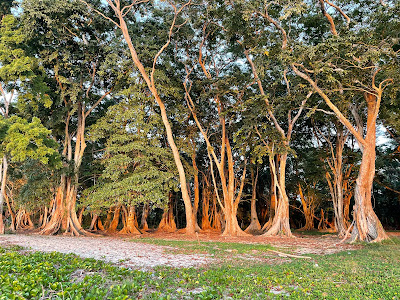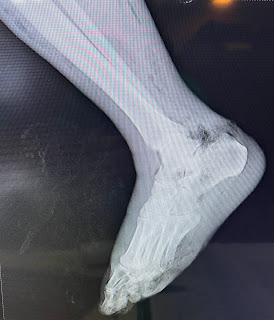Howling Monkeys, Hanging Bridges, Human Hearts, and Baleadas- My First Week as a Visiting Doctor in Honduras
When I wake up my first morning in Honduras I am greeted by howling monkeys outside my window- who needs a slew of iPhone alarm ringtones when you have monkeys?! The "howl" sounds like a cross between the roar of a lion and the bark of a dog- it's difficult to explain, but if you search howling monkey on Youtube, you will find yourself easily entertained. Just when I think my morning couldn't get any more wild than that, I put on my scrubs, wrap my stethoscope around my neck, and leave my apartment for the hospital. I am soon confronted with two hanging bridges surrounded by canopy trees that eagerly await my passage over a 100 feet gap above the rainforest floor. I can feel my heart already beginning to race, and for the first time in awhile, it isn't because I am running to a code blue or to the trauma bay to stabilize a patient. The first bridge is a wobbly one, and I immediately regret my decision to have both my hands full as I can't brace myself with the cables on the side of the bridge. After a few drunken-feeling steps, I start to get the hang of it by the time the second bridge rolls around, and I finally make it across on to solid ground. I can see the hospital now- a large white building with a cross at the top. I suppose every worthwhile destination is preceded by an arduous journey...
The hospital consists of a central courtyard surrounded by a network of "gears" that together make up a well-oiled machine dedicated to keeping the people of this Honduran community running. These "gears" include: "consultorios" or outpatient clinic rooms, three "quirofanos" or operating rooms, a handful of inpatient wards for hospitalized patients, a labor and delivery ward, a rudimentary but life-saving "ICU," an emergency room, wound and casting room, pharmacy, X-ray, laboratory, and counseling office. I am assigned to "Consultorio 5" which will be my office for the next 5 months. Did I mention one of the operating rooms has a view of the ocean? Yes, it's true! Luckily when performing my first C-section here this past weekend, I was on the the side of the operating table that didn't face toward the windows! In the end, I delivered a healthy baby boy- what better way to start my time here than by bringing new life into the world?
I have been in Honduras now for a week, and it's hard to believe I've already seen so much. My first day, I removed a large and inflamed skin mass from someone's buttocks- most likely not cancer, thanks be to God. If any of you have ever had something removed from your body and sent to a pathologist for evaluation, you most likely never had to carry it home and deliver it yourself to the pathology lab the next day! "That's how it's done here?," I thought to myself as I hesitantly handed the patient a plastic container that housed a chunk of his skin floating in clear fluid.
Earlier this week I saw a man in his 40s with progressive muscle weakness and muscle loss in his left leg followed by his left arm over the last year. After taking a history, doing a complete neurologic exam, and obtaining basic blood tests to rule out other causes of his symptoms, it appears that the patient likely has a form of amyotrophic lateral sclerosis (ALS), commonly known as Lou-Gehrig's disease. We are fortunate to be only 2 hours away from a larger city where the patient can undergo an MRI study of his brain and spine to rule out other causes for his problem. Sadly, if he indeed does have ALS, there is not much we can do for him in terms of treatment. Despite knowing his prognosis, the patient was immensely grateful and appreciative to finally understand what was going on with his body.
It is not uncommon here for patients to wait 4-6 hours in a hot, humid waiting room to be seen. Then, after they are seen by a provider, they may be sent to the lab for blood work or to X-ray. They then wait for results to come back and to see their provider again to discuss their results and plan of care. I even had a patient with a non-emergent concern stay overnight in our ED so he could be seen the next morning. They live 4 hours away and couldn't make the journey home in the dark. When I have a pile of patient face sheets on my desk in addition to hospitalized patients I need to round on, I am reminded of the patience, humility, and gratefulness of the patients sitting or lying in front of me entrusting me to their care. Indeed, they have just as much, if not more, to teach me than I can teach them.
I have seen many sad cases here- a 17 year-old boy with stage 4 rectal cancer suffering from excruciating pain, a woman with a vesico-vaginal fistula (abnormal connection between the bladder and vagina) suffering from urinary incontinence for years, and a 13 year-old victim of rape. I witnessed the pain in a daughter's face and heard the despair in her scream as she watched us do chest compressions on her dead mother in an unsuccessful attempt to revive her. Even in these experiences of immense pain and suffering, however, I witnessed the stronger forces of faith, hope, and love: one's brother carefully lifting him out of his bed to walk him out of the hospital, the dedication of a nurse practitioner and visiting gynecologist to help restore the function of a woman living in fear and embarrassment, a mother looking at the face of her newborn child with a smile, and the aching heart of a daughter whose love for her mother not even death could take away.
There are success stories as well. I admitted a man with severe pneumonia who without antibiotic treatment would most likely not be alive today, and he is almost ready to go home after making a speedy recovery. Our skillful midwife diagnosed duodenal atresia (abnormal development of the small intestine) after spotting a "double bubble" sign on prenatal ultrasound. Because of her early identification of this problem, she was able to arrange for the mother to be sent to a larger city hours away where she can deliver her baby safely in a hospital that will be able to care the complex needs of her child and increase his or her chance of survival. And I learned of the story of a young girl who attempted suicide by toxic ingestion of insecticide a few months ago- after a dedicated effort, the team here was able to ventilate her for 3 weeks and she is now doing well.
With long days working in the hospital, it's important to stay well-nourished. I discovered a staple of the Honduran northern coast: the baleada. It's a large and thicker tortilla laden with mashed black beans, cheese, egg, and sometimes meat. This, in addition to my morning routine of Honduran coffee, keeps me running. It's also important to pause, catch my breath, and reflect on all that I have learned in the time and experiences that I have been gifted. At the end of the day, I have the option of walking only 10-15 minutes to the beach where I can watch the sun set over the Honduran mountains and the waves undulate back and forth against the shore- both remind me that one day has passed, and there is yet another day on the horizon.
Thank you for continuing to support me on my journey, and I will continue to pray for all of you, my friends and family.






Comments
Post a Comment